Reviewing three new picture books in te reo Māori today is former teacher, gallery educator, librarian and student, Kay Benseman, along with her irāmutu.
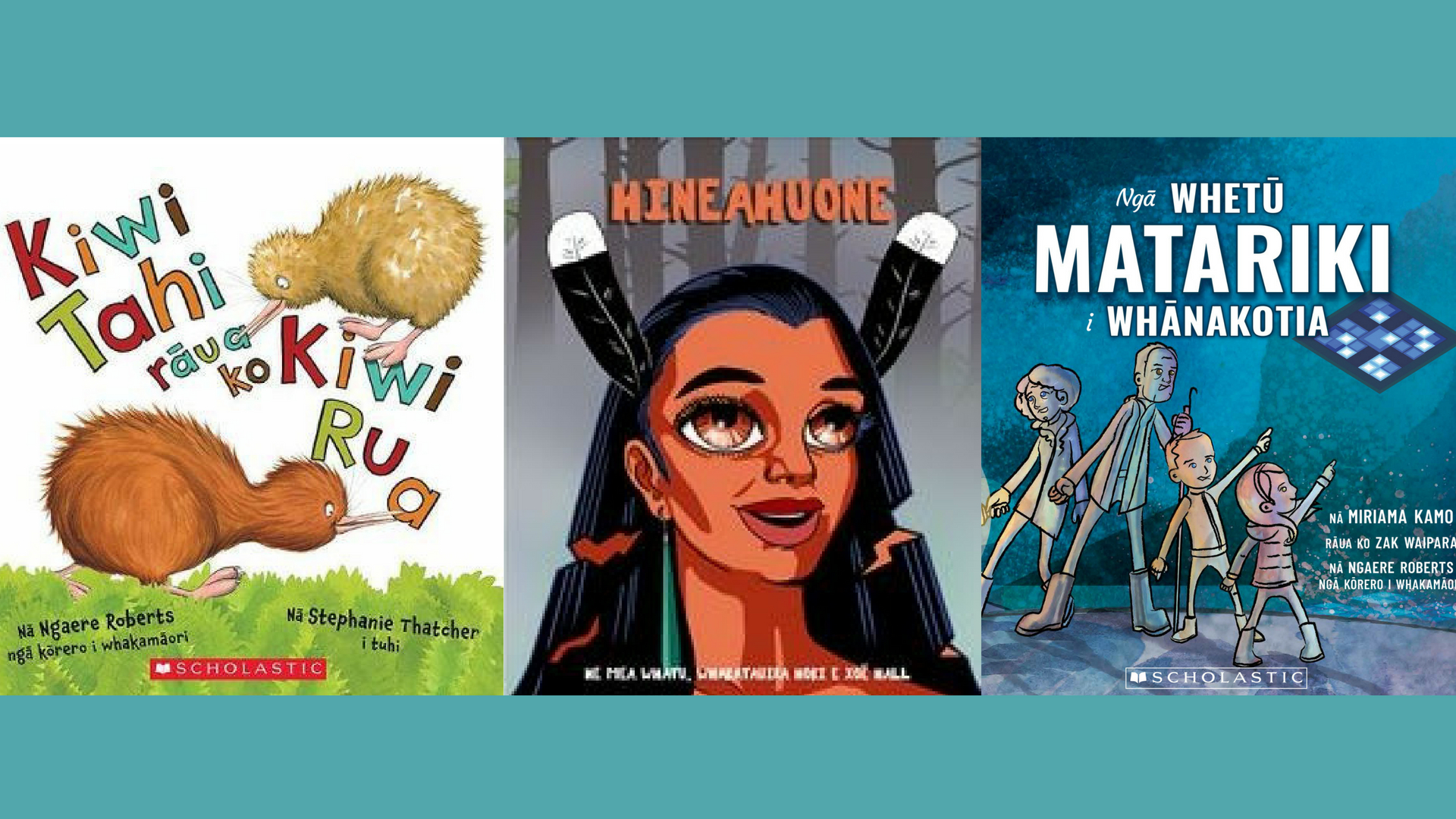
To balance my perspective as an adult second language learner, my clever irāmutu (niece and nephews) have also shared their reflections of these newly published te reo Māori picture books.
Hinengākau Cameron is 12 years old, her tungāne, Te Kaponga and Mangō-Ururoa are 9 and 6 years old respectively. Ko Ngāti Ranginui, Ngāti Rangiwēwehi, Ngāti Hinerangi ō rātou iwi. Nō Tauranga Moana rātou. Te reo Māori is their first language and as you will see, they are all discerning readers.
Kiwi Tahi rāua ko Kiwi Rua, nā Stephanie Thatcher i tuhi, nā Ngaere Roberts ngā kōrero i whakamāori.
Hinengākau: He rawe te reo. He pai kia whakaakongia ngā tamariki pakupaku. He tino pai ngā mahi toi o ngā manu nā te mea, he ātaahua. He tino pīwari ngā āhua o ngā kiwi.
Te Kaponga: I whakamārama pai te reo i ngā kaupapa.
Mangō-Ururoa: He pai te pukapuka, nā te mea he katakata tō rāua whakaoho i ngā ake kararehe.
This tale of two kiwi who wake up their forest friends to play with them all night long, is bright and cheerful and has an easy appeal to young readers. We meet a variety of friendly birds and reptiles native to Aotearoa in this entertaining story, adding this book to the large number of New Zealand children’s picture books featuring our endemic species. While it’s a great opportunity to learn new vocabulary related to Te Wao Nui a Tāne (kōtare: kingfisher etc), I can’t help but wonder if it’s time to move on from this motif?
The illustrations are really likeable and we can recognise a number of the cute characters that featured in Stephanie Thatcher’s earlier book (also translated into te reo Māori) Ka Hīkoi a Pūtangitangi/Pūtangitangi Walks.
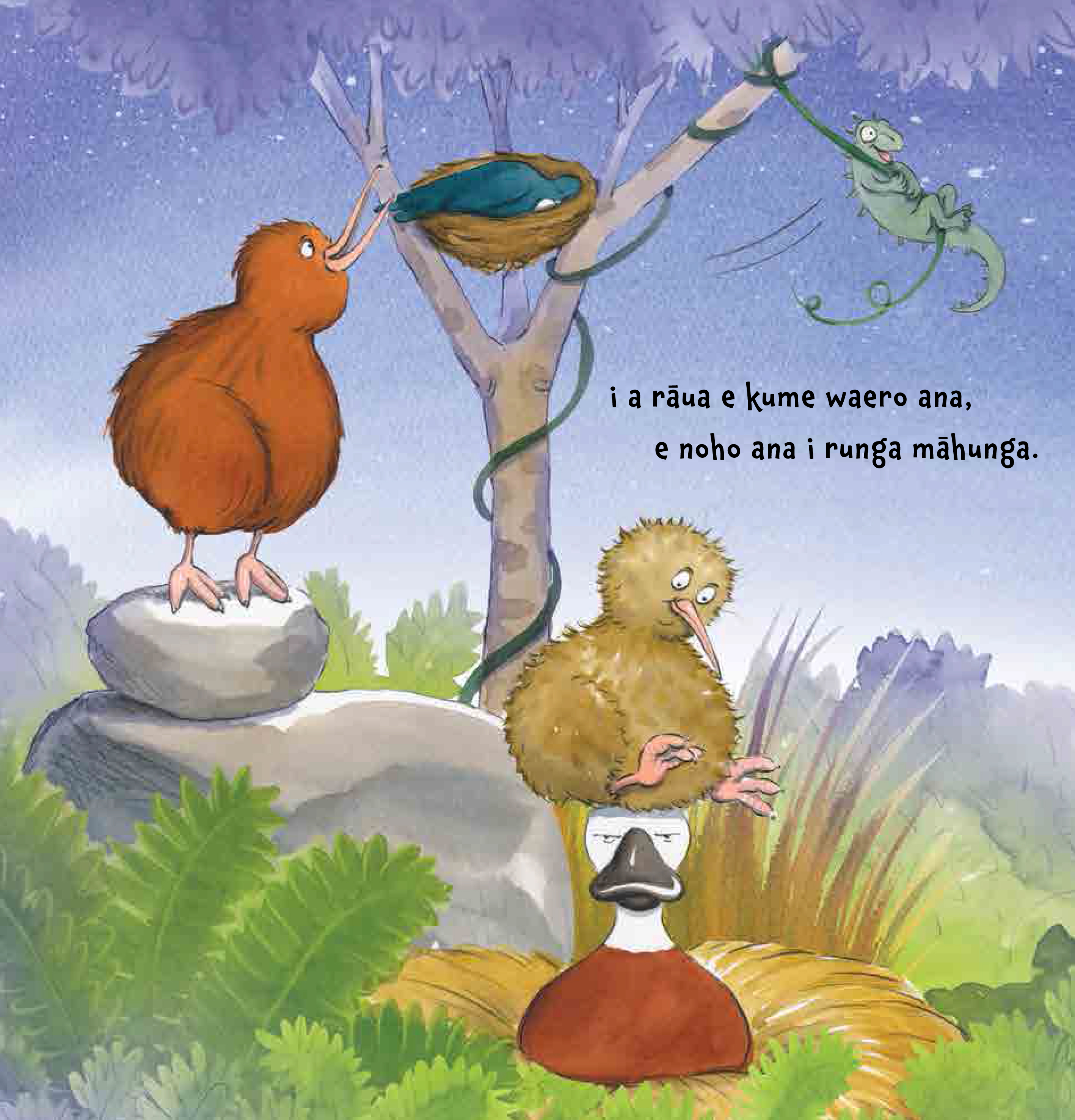
Unfortunately, the te reo Māori translation loses the rhyme that makes the English text such fun to read aloud. Picture books like this must stand up to telling after retelling at bedtime. I tested it on my 6 month old and 3 year old, but found myself tripping over the lines where some words rhymed and others did not.
Like many other adult learners of te reo Māori, I rely on the accurate macronisation (the dinky wee lines above vowels that indicate a double or long vowel sound like in ‘tūī’’) of written text to aid my pronunciation; I was disappointed to find a few macrons missing from this book.
A wonderful aspect, whether intentional or not, is that the main characters do not have a gender assigned to them. When I read the English text, there are no gendered personal pronouns. This is one of the many delights of te reo Māori, as this distinction simply doesn’t feature in the language. This makes Kiwi Tahi rāua ko Kiwi Rua/Kiwi One and Kiwi Two a wonderful book for anyone wanting to even out the gender imbalance in children’s literature that their tamariki are exposed to.
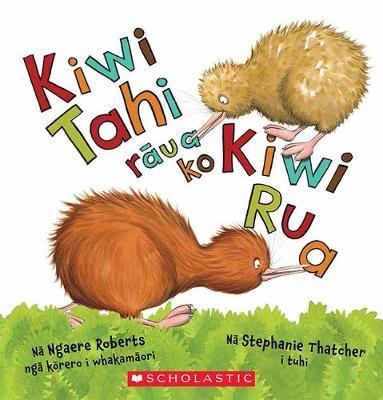
KIWI TAHI RĀUA KO KIWI RUA
nā Stephanie Thatcher i tuhi nā Ngaere Roberts ngā kōrero i whakamāori
RRP: $18.00
Ngā Whetū Matariki i Whānakotia, nā Miriama Kamo i tuhi, nā Ngaere Roberts ngā kōrero i whakamāori
Hinengākau: Āhua pai ngā kupu Pākehā, ngā ingoa ki roto. He pai ake mēnā he reo Māori te katoa. He rawe ki a au te mahi toi ki roto. He pai ngā kākahu o ngā patupaiarehe.
Te Kaponga: He pai te reo. Ka mārama au i ngā kupu. He pai ngā kiri pūaki.
Mangō-Ururoa: Ko ngā karu i āhua pango, me waiporoporo, nā he rerekē ki a au. Kāore i pai. Kāore i te mea nō ngā tāngata katoa ngā karu pēnā ai.
This book is a delight to read in te reo Māori and Zak Waipara’s illustrations are evocative without being too moody. It is a playful tale and the colourful pages set the scene for a mystical nighttime adventure.
The te reo Māori translation by Ngaere Roberts really does justice to Miriama Kamo’s storytelling and is easy to read and understand. Unfortunately, our macron patupaiarehe has struck again and there are missing double vowels as well as missing stars!
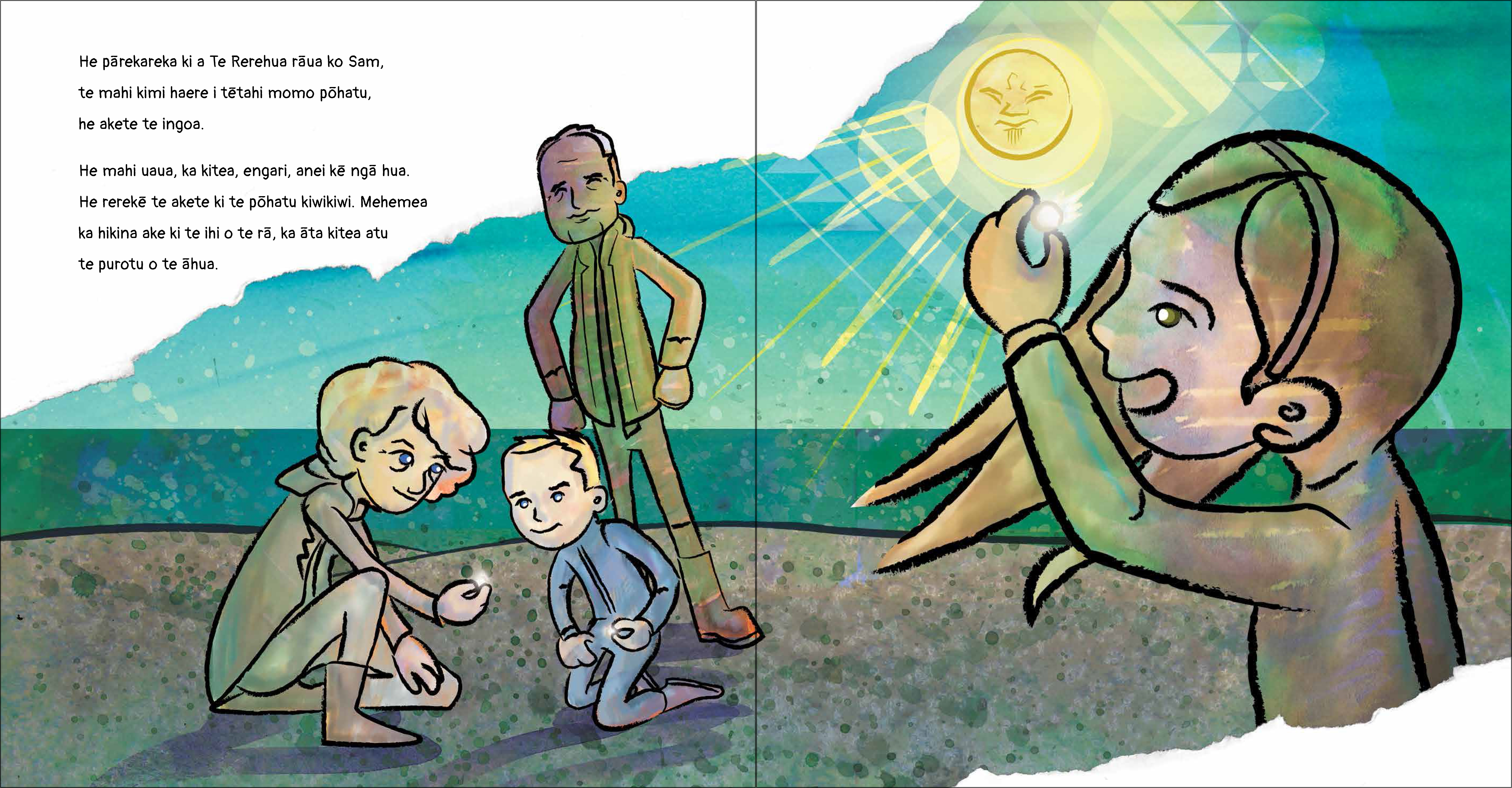
Spread from Ngā Whetū Matariki i Whānakotia, illustrated by Zak Waipara, translated by Ngaere Roberts
I enjoyed this interpretation of the recent inclusion of two more stars to our Matariki constellation; Pōhutukawa and Hiwa-i-te-rangi. As with Kiwi Tahi rāua ko Kiwi Rua, the glossary at the back is a really helpful inclusion and the English publication has footnotes for the te reo Māori vocabulary that has been delightfully scattered throughout the story.
As Kristin Smith discovered, this story is born out of Kamo’s own childhood experiences with her kaumātua and set on whenua very close to her heart. So much so, that she is donating funds from the sale of these books to the Lake Ellesmere/Te Waihora restoration project.
This is a lovely book to share with tamariki as we enter the Winter season of Matariki and Puanga, Māori New Year.
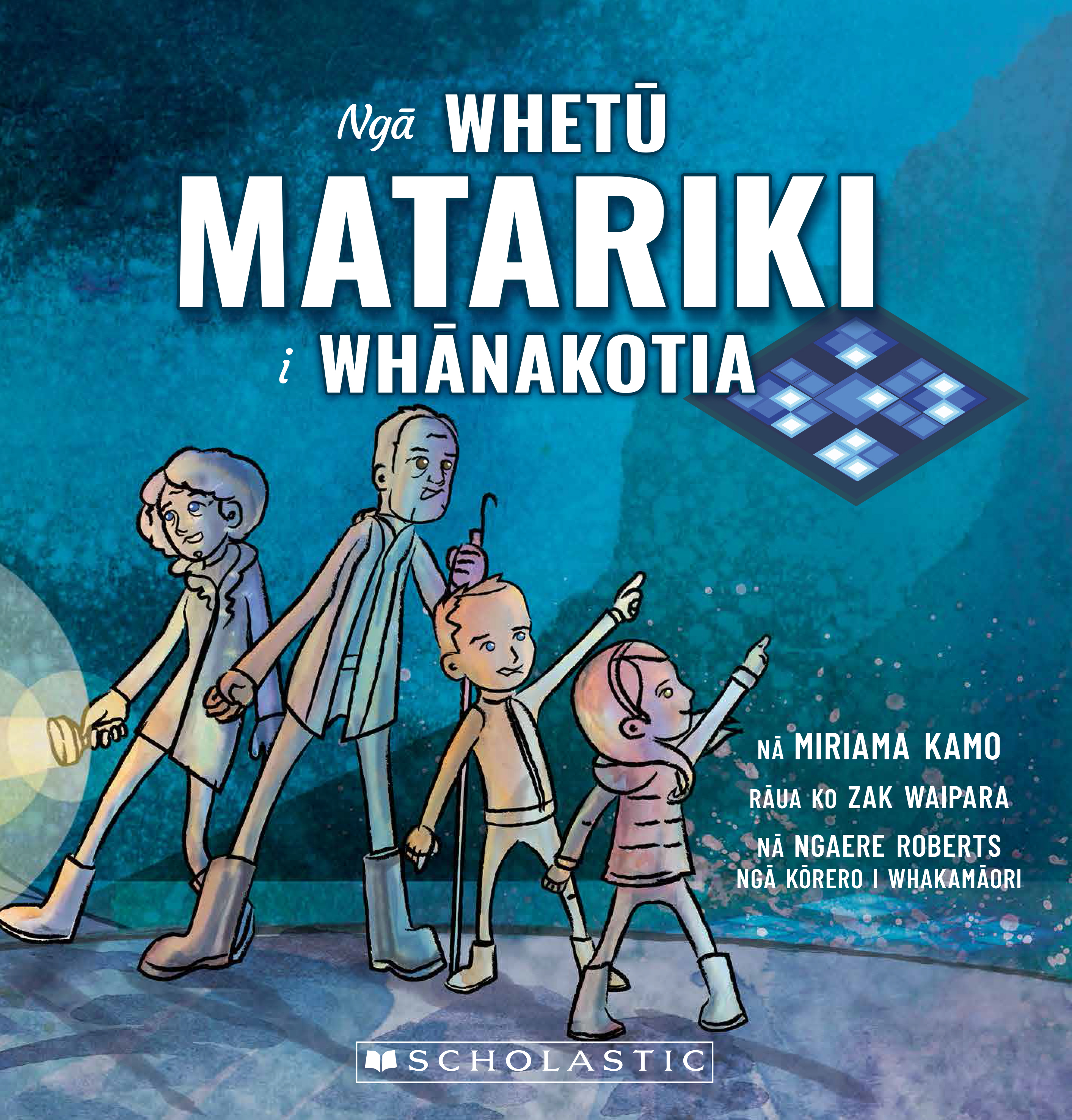
NGĀ WHETŪ MATARIKI I WHĀNAKOTIA
nā Miriama Kamo rāua ko Zak Waipara
nā Ngaere Roberts ngā kōrero i whakamāori
Scholastic
RRP $17.99
Hineahuone, he mea whatu, whakatauira hoki e Xoë Hall, nā Sian Montgomery-Neutze i whakamāori
Hinengākau: He pai te reo nā te koi o te kaituhi Māori te hoki mai, hoki mai, hoki mai hei whakatika te reo. He rawe te mahi o Tāne Māhuta. He ātaahua. He āhua pai ngā patupaiarehe, ēngari he rēreke. Kāore au i te mōhio i ō rātou ira. He pai ki a au i te kaupapa nei, nā te whakatakoto o te oranga o te tāngata.
Te Kaponga: He tino ōrite te tuhinga ki te kaupapa o ngā whakaahua. Kei ngā patupaiarehe ngā parirau pūrerehua. He tipua. He āhua pai te kaupapa o tēnei pukapuka. He āhua rerekē, nā te rerekē ki ngā atu pukapuka i pānuitia e au mō te kaupapa nei.
Mangō-Ururoa: He āhua uaua, nā te mea he iti te nui o ngā kupu, ā, e maha ngā kupu. He rerekē te āhua o ngā tāngata. Kāore tērā i te āhua o te tāngata Māori tūturu.
Strong, eye-catching illustrations accompany this retelling of the ancient pūrakau of how the atua of the forest and birds, Tāne Māhuta, fashioned the first human female out of clay.
It’s great to hear a new take on this story which, to my knowledge, hasn’t been published as a children’s picture book before now. It’s a complex tale to tell if you delve any deeper than Xoë Hall has, happily she ends this version before things get any more brutal.

This book is also missing macrons, which may not seem significant, but it really does make a difference to any speaker of te reo Māori. Not only to the reader’s correct pronunciation of the kupu, but also in their meaning; for example, ‘keke’ is cake and ‘kēkē’ is armpit – an important difference!
I felt that this te reo Māori version was a bit long and wordy for younger children but perhaps the Manga-esque illustrations will already give it appeal to older readers.
A feature I really liked was the space on the flyleaf for tamariki to name their new book; ‘Nā _______ tēnei pukapuka’, I can imagine many happy new owners of this pukapuka carefully filling this in. Hineahuone is shortlisted for the 2018 Book Awards for Children & Young Adults Te Kura Pounamu Award.
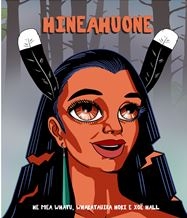
HINEAHUONE
he mea whatu, whakatauira hoki e Xoë Hall,
nā Sian Montgomery-Neutze i whakamāori
TeacherTalk
RRP $20

Kay Benseman
Kay Benseman (she/her) is a collector of quirky children's books and kupu hou. In the 90s, she worked in a bookshop and had a 40% staff discount, and her bookshelves have never recovered. With a background in education and the cultural sector, she is now a writer/researcher and Māmā to two curious children. He tāngata Tiriti ia, Kay is Pākehā living on Ngā Rauru whenua in Whanganui.



